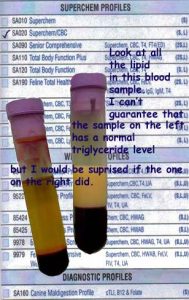Ron Hines DVM PhD
 See What Normal Blood & Urine Values Are
See What Normal Blood & Urine Values Are
 Causes Of Most Abnormal Blood & Urine Tests
Causes Of Most Abnormal Blood & Urine Tests
 Is my dog or cat a bit too chubby?
Is my dog or cat a bit too chubby?
The Triglyceride Level Of Your Dog And Cat’s Blood
Triglycerides are forms of fat or lipid. They are composed of a glycerine “backbone” with three fatty acids attached. Triglycerides and cholesterol are the primary fats circulating in the bloodstream. While glucose is our cell’s prime source of immediate energy, triglycerides are a stored backup source of energy for cellular metabolism.
Much your dog and cat’s blood triglycerides comes indirectly from the foods it eats. However, your dog or cat’s pancreatic enzymes must disassemble the triglyceride molecule into glycerine and its three fatty acid components before they can be absorbed. Both your pet’s liver and its body fat cells have the ability to reassemble triglycerides. Your pet’s liver also has the ability to change other absorbed nutrients in the diet into triglyceride and cholesterol.
Nature designed the body to utilize food carbohydrates moving throughout the body as glucose for its major source of energy. For that, we rely on the enzyme, amylase. Many dogs and most cats are not as efficient in doing that as humans are. Your cat has the hardest time thriving on a high carbohydrate diet. That is why fat in your cat’s diet is more important for them than for you. The triglycerides found in meat tend to be saturated fats. Dogs and cats evolved to handle saturated fats much better than we humans. It does not clog their arteries. Besides being an important source of energy for your dog or cat, triglycerides are essential components of the walls (cell membranes) of all cells in the body.
The amount of triglyceride and cholesterol in the blood tend to increase and decrease together. Read about the causes of high and low cholesterol here. When one or both are high, your pet is said to have hyperlipidemia. That situation is normal after a meal (lipemia). But when lipemia persists throughout the day, problems such as nerve and vision difficulties, seizures, pancreatitis and fatty skin patches (xanthomas) can develop.
Reasons Why Your Cat or Dog’s Triglyceride Level Might Be High (=Hyperlipidemia, Hypertriglyceridemia) :
As I mentioned, the most common cause of elevated triglyceride levels is a recent meal (a postprandial blood sample). That is why blood samples from your dog or cat, destined to be sent for tests that include a triglyceride/cholesterol assay, need to be obtained no sooner than 6 hours after the pet’s last meal. If the reported level came back high on a non-fasting pet, run them again after more time passed since its last meal.
Fat, inactive dogs and cats are more likely to have persistently high triglyceride and cholesterol levels. Over time, allowing your pet to remain that way is likely to have negative effects on its health. (read here)
In dogs, hypothyroidism is probably the most common underlying cause of persistent high triglyceride and cholesterol levels. Often the increase in cholesterol is higher than the increase in triglycerides.
Hepatic lipidosis is a common problem in cats that will not eat due to a number of health issues (anorexia). Such persistent fasting can cause the cat’s triglyceride level to be persistently high. Such cats need to receive nutrients (often through tube feeding) to prevent their downward health spiral.
Diabetic cats and dogs also often have high triglyceride and cholesterol levels until very late in their disease. Some believe that high triglyceride/cholesterol levels in these pets make their blood sugar (glucose) harder to control with insulin injections (insulin resistance).
Pets with sudden (acute) pancreatitis often have elevated triglyceride levels. It is unclear if it is the cause, or result, of the pancreatitis, but they are often found together.
High corticosteroid levels, either from medications or due to over-active adrenal glands (Cushing’s disease) can cause elevated triglyceride levels.
Triglyceride levels can also be high in chronic obstructive liver disease (= cholestasis) and occasionally in chronic kidney disease as well. We do know why.
Some breeds of dogs and cats have high triglyceride and cholesterol levels due to their genetic tendencies (just born that way). These genetic problems have complicated names, such as idiopathic or inherited hyperchylomicronemia, familial or primary hyperlipidemia and hypertriglyceridemia of schnauzers. When these genetic diseases occur, they are the result of excessive inbreeding. Breeds associated with these genetic problems include miniature schnauzers, Brittany spaniels, beagles, Siamese cats, domestic shorthair cats and Himalayan cats. Pets with this problem need a well-thought-out, lower fat diet. I prefer that you make it at home from human-quality ingredients under a veterinary nutritionist’s supervision. Some suggest a fish oil supplement.
A peculiar and rare form of diabetes in cats due to a tumor in the pet’s pituitary gland (adenoma-induced acromegaly) is also reported to cause high blood triglyceride levels in cats. That is due to the over production of growth hormone (GH). (read here)
Methimazole (Tapazol®), given to control hyperthyroidism in cats, is said to sometimes elevate a cat’s triglyceride and cholesterol levels. Megesterol or depopovera® – occasionally given to cats with Eosinophilic granuloma complex or miliary dermatitis can also increase triglyceride levels.
Complementary Tests:
CBC/ WBC, blood chemistry values including a blood glucose screening for diabetes in dogs and in cats, cholesterol level, Thyroid panel for hypothyroidism (free T-4), ACTH stimulation test or low dose dexamethasone suppression test to screen for Cushing’s disease, TLI, cPL® for dogs or fPL® for cat to screen for pancreatitis, fructosamine test to screen for diabetes in dogs or in cats, urinalysis including protein:creatinine ratio, microalbuminuria test
DxMe
You are on the Vetspace animal health website
Visiting the products that you see displayed on this website help pay the cost of keeping these articles on the Internet.


